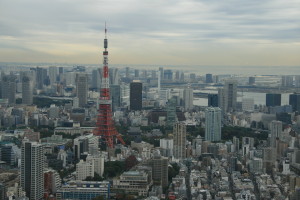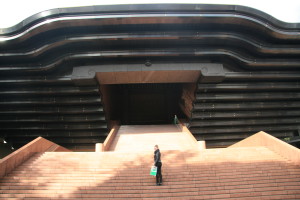curves ‘n concrete
War, fire, urbanization, scarcity. These and not a fetish for concrete and ugliness are the reasons Tokyo, to many, looks like a tormented soul. But like a rose grows from the thorn, like an ugly duckling, all Tokyo needs is some time. Time to get to know her beauty. Time to undo what has been done to her appearance.
First time visitors usually get blinded by the city’s neon make-up. Some get lost in the labyrinth of its vast subway system. Are deafened by the sounds of millions. Can’t get their bearings by the lack of architectural icons. It’s all very imaginable. Tokyo is a metropolis with a population of over 13 million. An urban giant. The centre of the largest (36 million people) metropolitan area in the world. Make your way up to one of the many observation decks on Tokyo’s skyscrapers or the brand new Sky Tree and all you see is concrete. All the way to the horizon where, when you’re lucky and skies are clear, the concrete kisses Fujisan.
A good start for some city gazing is Roppongi Hills. This mega project is all the new Tokyo is about: a mix of concrete, water, nature, first class architecture and culture. Not coincidentally, Roppongi Hills is also the beginning and end of an 8,6 kilometer long contemporary architecture route. A route by foot through a large part of Minato-ku, featuring museums, temples, a church and an Eiffel Tower look-a-like.
As said the starting point (A & G on the small map at the bottom) is Roppongi Hills. Here you find street art like the Giant Spider sculpture, small parks with a pond filled with extraterrestrial fish, the National Art Centre and the fine Mori (contemporary) Art Centre that offers both world class art and 360 degrees Tokyo views. (Web)Address: 6-10-1 Roppongi, Minato, Tokyo.
Should you not have had enough of the views over Tokyo and, hopefully, Mount Fuji, your next stop is Tokyo Tower (B on map). This 55 years old copy of Paris’ Eiffel Tower offers some great photo opportunities, both from its base as from 1 of the 2 observation decks at 155 and 250 meters. Standing on the highest deck brings you on eye-level with folks standing on the Mori Art Centre observation platform which you already filled in the ‘been there, done that’ department. (Web)Address: 4-2- 8 Shibakoen, Minato, Tokyo.
After visiting Paris in Tokyo, you’ll come down to earth and walk until you reach a different state of mind at the Reiyuka Shakaden Temple (C). This starship like temple (also referred to as Darth Vader’s helmet) is both a haven for the priest less Shakaden Buddhism branch as well as a 400 ton calamity water storage in case of earthquakes or an attack by Godzilla. Whatever function of the temple you prefer, the architecture of the place is quite overwhelming. (Web)Address: 1-7-8 Azabudai, Minato-ku, Tokyo.
Descended once again from heaven to earth, your feet will take you to another kind of religion: fashion. You’ll find that Tokyo Midtown (D) is both posh and relaxed, featuring all the luxury brands in the world as well as tons of culture. The Suntory Museum of (Japanese) Art, the (graphic) Design Hub, the Fuji Film Square (photo gallery) and a masterpiece by the Japan’s star architect Tadao Ando: the 21 21 Design Sight. This gallery like concrete treasure chest has its finger on the pulse of Japanese design, organizing regularly changing exhibitions. After visiting Ando’s creation, you might want to opt for a Lost in Translation like bar experience and enjoy a drink and city view on top of 21 21 Design’s neighbor, the Ritz Carlton. (Web)Address: 9-7-6 Akasaka, Minato-ku, Tokyo.
After cocktails and hors d’oeuvres at the Ritz, the route takes you to E on the map: another temple. This one being less overwhelming than Reiyuka Shakaden. The Baisoin Temple is actually more in line with Ando’s work. It has a minimalist design, which is both functional and blended in with its surroundings. Still, the use of an ancient wooden gate and bamboo entree that contrast with the slick glass, steel and concrete of the temple building is soooo Japanese. (Web)Address: 2-26-38 Minami Aoyama Minato-ku, Tokyo.
On we go, and again the goal is religious and hidden in the narrow alleys of Shibuya: the Harajuku Protestant Church (F on map). This is an example of organic architecture. Following natural curves and the scarce city sunlight, the church has captured the heart and mind of many visitors, in an architectural way. Best is to check up front what times it is open for visits or services since looking through the glass door is good, but stepping inside is better. (Web)Address: 3-42-1 Jingumae, Shibuya, Tokyo.
When church is out, you can head back to Roppongi to choose from an abundance of haut cuisine (expensive) small restaurants, dine with countless Gaijin in ‘Kill Bill’ restaurant Gonpachi, or (much) better, bow your head and enter one of the tiny izakayas marked with a red lampoon.
Starting point:
Roppongi Hills
6 Chome-6-10-1
Roppongi
Minato
Tokyo
106-0032
Japan
W: www.roppongihills.com
Ready for more architecture and some subway rides? Then check out these works of art:
1) St. Mary’s Cathedral by Kenzo Tange: Bunky-ku, Sekiguchi, 3丁目16#15
2) Jiyu Gakuen Myonichikan by Frank Lloyd Wright: 2 Chome-31-3 Nishiikebukuro, Toshima
3) Nakagin Capsule Tower: Chuo-ku, Ginza, 8丁目16#10
4) Asahi Beer Hall by Philippe Starck: 130-0001, 1丁目, 吾妻橋, 23, 墨田区, 東京都 130-8602
5) National museum of Western Art by Le Corbusier: 7-7 Uenokoen, Taito
6) Edo Tokyo Museum: 1-4-1 Yokoami, Sumida
[mappress mapid=”96″]





